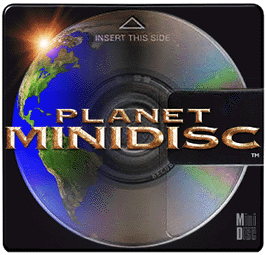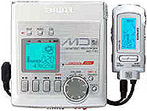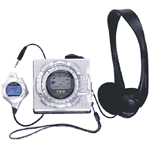|
Modern recording
for DXers
By Charles Rippel
and Guy Atkins
August 30, 2000
Published with permission from the
R390 web site
Throughout the radio hobby, establishing and maintaining
a record keeping system is an important facet of active participation.
Regardless of which segment of the electromagnetic spectrum the
listening enthusiast chooses to pursue, keeping track of what,
where and who was heard is important. This allows the hobbyist
to set and meet goals as well as document what exactly was heard.
Many listening enthusiasts use strictly written records while
some use a combination of written records and some form of audio
archive. With the increasing difficulties in obtaining written
QSL’s, many DX’ers are taking the position that a clear recording
of a broadcast with a station ID confirms that a given target
was heard. The purpose of this article is to help those
who make audio recordings of what they hear utilize the latest
technology to capture their audio.
In the
past 20 years, cassette recording of radio programming was
the format of choice. The medium is small, easy to handle
and portable. Recording equipment could be purchased at
reasonable pricing which was capable of making very faithful recordings.
Technological improvements produced reliable, portable equipment
which was equally useful at home or it could be taken into the
field on DX’peditions allowing the DX’er to return with exciting
clips of audio from rare stations.
For
all its convenience, tape recording has its shortcomings.
Audio recorded on cassette tapes tend to be “hissy” even when
Dolby noise reduction was used. The low, 1-7/8 IPS speed
allowed for quick tape saturation when a signal faded up suddenly
resulting in distortion or sometimes inaudible passages in the
recording. Finally, indexing or keeping track of what
was actually on a tape is cumbersome at best. Written notes
must be kept against tape index counter readings. If the
notes become lost or accuracy during an active listening session
is compromised, the usefulness of the recorded audio is academic
at best.
Time and
technology have presented several new formats of audio recording.
Digital Audio Tape (DAT), writeable CD and Minidisc (MD) are but
a few. Because of the unique capabilities offered to the
radio hobbyist, this article will focus on integrating the Minidisc
format into your listening hobby. Also, we’ll look at a
few Minidisc models to illustrate the various useful features
the medium offers.
The
recordable Minidisc is a reusable medium whose appearance is approximately
that of a standard 3-1/2” computer floppy disk. However,
the MD is smaller at about 2/3 the size of the size of the floppy.
The discs are offered by the major magnetic media manufacturers
such as Maxell, TDK, Sony, etc. As of this writing,
a pack of 4
Maxell Gold MiniDiscs sells for $7.99 with a free case
offer on the Internet at Planet
MiniDisc.
 That’s
about 600 minutes of mono record time representing the equivalent
of 6.6 - 90 minute cassettes. That’s
about 600 minutes of mono record time representing the equivalent
of 6.6 - 90 minute cassettes.
Through its digital ATRAC coding system, a single Minidisc is
capable faithfully recording an exact digital copy of up to 74
minutes of stereo audio on as many as 254 separate tracks or individual
cuts. On hardware so equipped, the recording
time is approximately doubled when program material is recorded
in mono. This is exclusive of the new MDLP
mode, explained later in this article.
An important feature for the hobbyist, a Minidisc can hold
up to 1,700 characters of user programmable text, numbers and
characters that are used to label each track or selection recorded.
The
MD disk itself is written and read with a low power laser thus,
typical specifications are about the same as a CD. Frequency
response is 20-20,000 cps +- .3db, undetectable wow and flutter,
signal-to-noise ratio in excess of 100db, etc…. Audio can
be input and output from most Minidisc equipment in a variety
of methods. This includes conventional line level audio
connected VIA RCA plugs. For the musical purest with compatible
equipment, some machines offer direct digital input VIA a single
coaxial input or, in the case of the more upscale equipment, the
digital signal is opto-coupled from the audio source VIA a single
fiber-optic cable. The radio hobbyist will most likely to
use the RCA inputs to couple line level audio from their receiver
to the recorder. As a bonus, the Minidisc format also offers
better sound quality in the stereo mode than todays CD players.
This is because Minidisc uses 20 bit sampling, resulting in higher
audio resolution, as compared to the 16 bit rate used in todays
modern CD players.
Minidisc
recorders are available from most of the major Japanese electronics
manufacturers. There are home units about the size of a
CD player, which run off the commercial power mains. Some
manufacturers also offer portable models whose footprint is no
bigger than 2 credit cards yet are full featured and can operate
for many hours on various types of batteries. Sony
seems to offer the broadest line of home recorder/players and
there are several excellent brands of portable and even car units
(players) on the market as well.
As
the hobbyist begins to read the product literature from the various
models to choose one which best suits his or her need, they can
be quickly overwhelmed by the many product features recording
in the digital realm offers.
A good
way to start the selection process of an MD unit is by visiting
the Minidisc
Community page on the Internet. Here,
you can learn about the various features such as editing modes,
track indexing and synchro-recording offered by the MD format. What
is easy about selecting a Minidisc recorder for hobby use is to
identify a few features Important to the DX’er then use that criteria
to help make a hardware choice.
Perhaps
one of the more unique
characteristics of the format is the ability to add user chosen
titling information to each recorded track. As the selection
is played back, the titling information appears back on the players
main display in one or more lines usually by scrolling.
The titling information is entered as the initial recording is
being made or during a later edit.
Where I recording
a 25M reception of All India Radio, a basic entry might consist
of the following which the recorder would encode as data onto
the disc which would display as the audio is played back:
AIR Bangalore
11.620 MHz 2142 UTC 08/19/00
With this
45 character note scrolling across the screen of the player, there
is little doubt as to what the program material is being played
back. I noted the station name, frequency and that the recording
was started at 2142 UTC (more on time labeling later). The
date was August 19, 2000.
A more detailed
description for the same logging might read:
AIR Bangalore
11.620 mHz 2142 UTC 08/19/00. Note ID by OM
@ 0:18.0
In the case
of the detailed description of my AIR logging (68 characters),
some additional detail was added to indicate that at 18 minutes
into the recording, there was an ID by a male announcer.
You may title each selection if you wish and what is written and
its format is completely your choice.
Because
the Minidisc recording system works in real time, most hardware
offers several modes of accounting for both playing and recording
time. Time into track, length of track, time remaining on
disc are but a few of the time display modes. On a personal
note, I always label my recordings as to exactly what time they
start. I can then refer to the time into track to correlate
the occurrence of a recorded event with the actual time at a later
date.
That said,
Guy Atkins points out that many, but not all, of the Sony MD recorders
include a "running" time & date stamp feature that is useful
to the DXer for extracting loggings & reception report details.
After the current date and time (UTC preferred) are entered on
the appropriate Sony MD recorder, the unit encodes the information
on the disc itself in "real time". The feature makes entering
the time & date on the track title an optional step, as it
is retained separately by the time/date stamp. I believe that
the Aiwa portable MD unit, mentioned later in the portable section
of this article, provides for a "static" time/date stamp at the
beginning of each track, but it is not the more useful running
time & date feature found on most of the Sonys. (The Sony
MZ-R37 portable is one of the models without time/date stamp,
as it is more of a stripped-down economy MD.)
The titling
feature is key and can be a very powerful aid to the radio
hobbyist. Entering the correct, beginning UTC time and date
into each track's title is a straightforward way to account for
this information. However, the DXer planning his first MD purchase
may want to give priority to Sony for the convenience of this
feature.
Because of
the potential power of titling, pay particular attention to whether
a particular piece of hardware, be it a home or portable unit,
offers the ability to title tracks. Nearly as important
as the feature allowing the machines to title a track is how the
user must go about adding the text. Most home and all portable
units allow the text to be entered VIA multi-function keys or
controls on the front panel. Some home units allow the text
to be additionally entered VIA a remote control.
I particularly
like a feature offered by both the Sony
MDS JB-930 (Street price: $319 US) and the soon to
appear MDS JB-940 which allows a standard computer keyboard to
be plugged right into the front of the machine. All text
entry, including upper and lower case alphabet, numbers and punctuation
can be conveniently typed in from that keyboard. Additionally,
some functions of the machine can also be controlled by entries
VIA the keyboard in addition to the usual front panel and included
remote controls. Additional information about Sony MD Products
may be obtained at Sony's
web site. Guy Atkins also points out A relatively
inexpensive model of MD recorder that uses a PS/2 keyboard for
text entry is the Sharp MD-X5. This unit is a mini stereo system
that includes a MD recorder, CD player, AM/FM tuner and two bookshelf
speakers.
The PS/2
keyboard port is the number one reason choose the Sharp model
to supplement my portable MD. Further details and a picture can
be found by clicking
here.
Hardware
equipped with
the mono recording feature (sometimes called “extended play”)
is becoming increasingly difficult to locate but is important
feature for the hobbyist. There was some controversy
concerning high frequency loss caused by the algorithm used to
digitally encode and thus enable monaural recording.
The frequencies were the loss occurred were well beyond the range
needed by the hobbyist yet, some manufacturers may be by-passing
the issue by simply deleting the feature on newer machines.
Indeed the Sony MDS JB-940, which will replace the MDS JB-930,
does not list monaural recording as a product feature. That
issue can be reviewed at the Minidisc
Community web site.
A recently
introduced long play mode of MD operation, MDLP
Mode offers the DXer the opportunity to record up to 320 minutes
of *stereo* audio on a single disc. This is nearly 5-1/2 hours,
folks! Due to the limitation of MDLP there is no corresponding
2X monaural mode.
MDLP actually
represents two new stereo modes, LP2 and LP4. Full details may
be found by clicking
here, which includes a link to the currently
available equipment which includes MDLP.
If you're
thinking of buying MD equipment in the months ahead, watch for
the MDLP feature, especially if your DXing style includes long,
unattended recording sessions.
If you
cannot locate a home player with monaural recording, there
is an easy work around albeit with the loss of the double record
time advantage. Simply combining the right and left RCA
inputs with a simple “Y” adapter from your local Radio Shack works
fine.
Home recorder/players
range in price from $159 to over $700US.
Portable
players offer many of the same features but in a much smaller
package. All of the MD format advantages, including the
excellent specifications, apply to portables. The
footprint of the typical portable is tiny and approximates 2 credit
cards laid side by side or, about 3-1/8” W X ¾” thick X
3-1/2” D (78.8 X 18.8 X 86.8mm). The players are just slightly
larger than the actual MiniDisc.
Battery
life for a typical new technology portable is excellent.
One machine quotes 34 hours of playback or 13 hours of recording
time on just 3 “AA” cells. Newer machines even offer latest
technology, rechargeable Lithium Ion cells which have excellent
capacity but none of the charge “memory” issues associated with
conventional NiCad’s.
Interestingly,
most of the portable machines are so small, standard “AA” cells
will not fit in the case and must be located in a separate battery
case. Some players come equipped with a specially sized
rechargeable battery that will fit inside the case making a neat,
easily portable package great for DX’peditions.
Due to
their size, portables have a few additional issues including
the ones mentioned for home units to be aware of. Some portables
do not offer manual input gain controls. Instead, an audio
ALC circuit is employed which while sophisticated, may not be
able to properly ride gain on something like a static crash.
Because of
their small dimensional size, the controls are likewise small.
This can cause operations such as titling and editing to be a
bit challenging. However, when faced with the choice of
using a cassette or a portable MD, the MD wins hands down
every time.
Like portable
CD’s, MiniDisc players are very rugged. Many use an
anti-skip design which “remembers” a certain number of seconds
of previously played material but on an ongoing basis. Should
a shock occur and the data feed from the disc interrupted, the
player will digitally reconstruct the audio from the previously
memorized audio data. Know that like all home electronics,
getting a MiniDisc player wet is its death-knell. The lead
in the solder used in the assembly of the circuits will begin
to corrode and the process is not repairable or reversible.
Finally,
make sure the model of choice offers a Line Level Input.
It is this input which connects to the line level audio output
of your receiver. Pass up units which offer only a microphone
or digital input.
A couple
of portable models which offer the features used by the hobbyist
are the Aiwa AM-C80 and Sharp MD-MS722.

|

|
| Aiwa
AM-C80 |
Sharp
MD-MS722 |
Both offer
titling and mono-recording. I choose the Aiwa model as the
US model features an included “Car Kit” which enables the unit
to play through my car stereo VIA a special cassette configured
as an input device. A cigarette lighter plug, regulated
to the appropriate voltage, is also part of the “Car Kit.”
Portable
recorder/players range in price from $100US all the way to $1,300
for the Marantz PMD-650.
Watch
the sales but be very careful about Internet purchases.
Many of the US based divisions of Japanese manufacturers will
not honor warranty coverage on products generally bought over
the Internet unless it is through an “Authorized
Internet Dealer”,
such as Crutchfield
and J
& R Music World.
©
2000, Copyright HCDX and authors.
Notes on the
versatile Minidisc
By Guy Atkins
1.
Sony and JVC have recently announced new models that support two
additional long-play modes. The "LP2" format provides 160 minutes
of stereo recording, and "LP4" provides 320 minutes of stereo
recording on a single Minidisc blank. Presumably, a monaural variation
of these new modes would give 320 and 640 minutes respectively...
very useful for the DXer!
Currently, 160 minutes mono, with a 80-minute stereo MD blank
is all that is possible with Minidisc. Nice, but it would be super
to have 10+ hours of unattended recording in a LP4 Mono mode.
Please see the 7/18/00 news item at the Minidisc
Community Page.
2.
I recently sold one of my minidisc recorders and replaced it with
a Sharp MD-X5, a mini stereo setup that includes CD player, MD
recorder, AM/FM radio, and bookshelf speakers. More importantly,
this model has a built-in PS/2 port for attaching a PS/2 keyboard
for easy entry of disc and track titles! Lately, this particular
model has been available as new surplus on eBay, with high bids
between $150-170. This is a very good price for a keyboard-entry
MD.
The Sharp models do not include the useful "running date/time
stamp" as found on many Sony MD units, but the time/date can be
easily input as part of the track title.
Details of the Sharp MD-X5 can be seen at
Minidisc Community Page.
|



